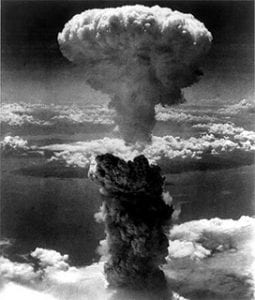Atomic bomb mushroom cloud from Big Man (plutonium bomb dropped on Nagasaki); the photo was taken from the B-29 “Necessary Evil” on August 9, 1945. [https://www.flickr.com/photos/syarifphoto/4856001868/in/photolist-8p7hb9-9A1tfU-a8yNQK-6xbVwe-5jwnnZ-9EWy4v-kPYCMr-88GxNd-8UiKqr-25aEwnH-afGYsa-7XfdYY-6jKoV3-32fLAr-bcEARP-8ZK96r-8UmFXC-6bhYbF-8jTepz-928WXb-5firzW-7vWUWp-kQ1DFq-4pv5Yh-uX6b3-8UmGBS-6G9Dp7-dpSeXZ-e2fMkZ-5c1XD3-4Qw5Nw-83zbYd-bcheU2-2fng2r-4T2N7W-7MPo8S-s8Ac1M-7YJXNr-awHzrm-7X8Fkj-8eXsdd-9K4Q4v-8UmLtQ-6G19YX-ebMQvR-8UmLb7-5FphuK-bBj7fs-asuFVv-AZ7sd]
Author: Colin Mullally
Interviewer: Justin Ward
The bombing of Hiroshima and Nagasaki, two of the most controversial decisions in wartime history, are often not explored within the context of the evolving diplomatic relationship between the Soviets and the United States. Instead of simply ending the war and bringing home the troops, copious amounts of material suggests that alternate rationales for the destruction of Hiroshima and Nagasaki. The atomic bombings of Hiroshima and Nagasaki on August 6th and August 9th of 1945 were to receive surrender from Japan before a Soviet entry into the Pacific War, effectively firing a warning to the USSR.

